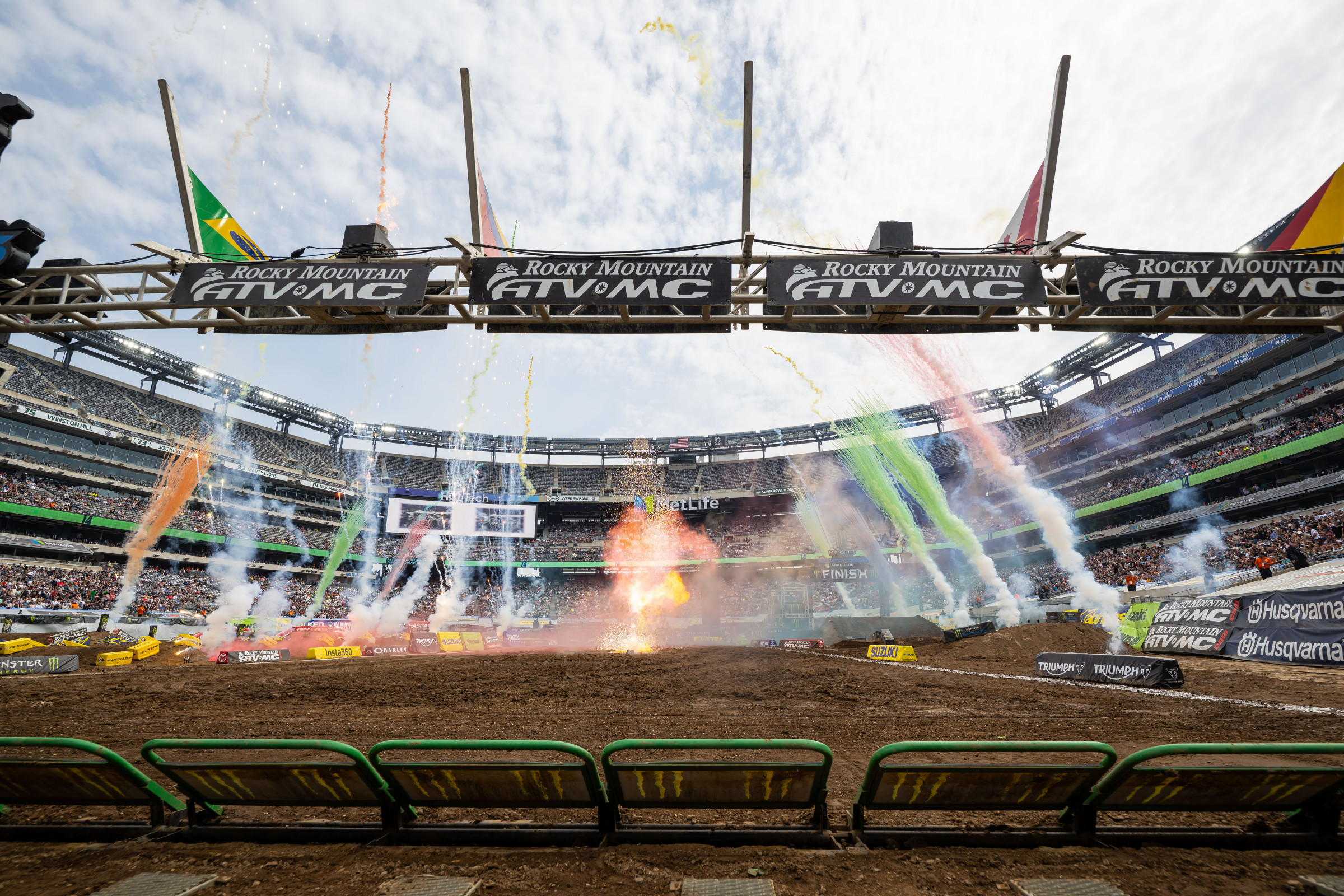The 2025 season of Monster Energy AMA Supercross is steaming toward a conclusion, and with the championship up in the air, each race is getting more and more intriguing. That was definitely the case in East Rutherford too, where Chase Sexton put on a master performance. To get a better understanding of what went down over the weekend we sent questions over to former pro and NBC reporter, Jason Thomas.
On the broadcast Ricky Carmichael mentioned there being pebbles on the track. What did he mean by that, and how did it affect the way the riders interacted with the racing surface?
The soil does have a lot of rock in it. Think about Unadilla years ago and how much rock is inherently in the dirt for this region. That loose rock (pebbles) makes the surface less predictable. Both tires are more likely to “push” because of those pebbles. They create inconsistency in the traction and its another variable for riders to manage.
Other than pebbles, what were some of the challenges the track in East Rutherford presented that were unique to this round?
This was one of the more technical track layouts we have seen in a while. The rhythm sections were not only challenging, they led to very dicey corner set-ups. The triple into the corner where Chance Hymas crashed was very difficult to execute. Riders were tripling to the inside and carrying momentum through the corner and into the next standard triple. Riders needed to land precisely on the downside if they wanted to get enough front end traction to corner. Land too short, you risk crashing like Hymas. Too long and you would push through the apex still in a straight line and be forced to double the triple at best.
The other tough section was the step-on step on-off before the finish line. In full sprint mode, riders would execute to the inside and again, be faced with a flat corner with minimal traction into the finish line jump. The jumps were difficult, sure, but executing the corners after were even tougher.
There were two whoop sections, back to back. The way the track was built, riders were able to carry a higher entry speed into the first set. Describe the different attack strategies for each whoop set.
That first set was begging for high entry speed and blitzing. Crossing over the starting line gave riders ample room to build speed and for those who wanted to jump through, it created a real problem. Jumping only gives an advantage if speeds are slow or blitzing is difficult to execute consistently. With a highspeed entry like Sexton was wielding, jumping was always going to be a losing proposition.
The second set was a little different. The corner before was tighter and therefore more challenging to create entry speed. Sexton was doing a great job of getting through these and Webb was also getting a nice rhythm in the second set. Webb was maybe losing a little time but the first set was much more punitive. That gap before the first set was a small nuance on a very technical track but it had powerful repercussions on the stopwatch.
Grant Harlan was in fourth place, the last qualifying position, in the LCQ. How difficult is it to be in that position, especially for Harlan, who’s already thrown it away a few times this season while holding a transfer spot?
It’s a nerve wracking experience, especially when pressure is being applied. The best thing that Harlan could do was, at all costs, create a gap between himself and fifth place. If Cade Clason got right on his rear wheel, he would have to choose defensive, slower lines in every corner. He would have to disallow Clason to get an angle for a block pass, which typically just slows the pace down. If he can maintain a large enough gap where Clason isn’t within striking distance, he can focus on going as fast as possible. In this instance, he was able to do just that.
Chance Hymas crashed hard in the main. It happened so fast it looked like someone jerked a rug out from underneath him! What happened?
In the aforementioned section where riders were tripling to the inside, Hymas was a little outside of the preferred line but the ask was the same. Landing precisely on the downside was a requirement to make the corner. He simply got it a little wrong, came up a little short, and was likely more concerned with braking than a crash. The violence of coming up short caught him by surprise. If he was only concerned with not crashing, he would have been able to save an otherwise small incident.
RJ Hampshire got second, which is a great result, but he never got close enough to pressure Seth Hammaker at all. Were you expecting more from him in East Rutherford, or is this a testament to how well Hammaker was riding?
Hammaker was fast all day. When he has gotten out front this season in qualifiers or the main events, he hasn’t been overtaken that I can remember. I believe it’s the latter in your proposed reasoning. He has found some serious pace and more importantly, he isn’t making the critical mistakes that have long plagued him. It’s a serious transformation we are witnessing.
Things didn’t go the way Tom Vialle wanted in East Rutherford, but he seemed to be riding with some extra spark. Was that the best he’s ridden all season?
I’m torn on Vialle right now. He’s been good but good likely won’t win a championship. His consistency had been enough to keep him boasting a red plate but with that Foxborough mess, now that strategy isn’t going to cut it. He is simply going to have to find a way to win in Pittsburgh, or get a lot of help at the SLC showdown if not.
Justin Barcia and Aaron Plessinger were going at it for what seemed like forever. Were you surprised Barcia was able to maintain that pace (before eventually crashing) with the finger laceration he’s dealing with?
Adrenalin is a powerful asset for racers. When battling for a podium, Barcia would likely not remember or care about his finger and the adrenalin would mask any pain. It’s the in between times and training during the week that would suffer. If it’s only a week or two, that won’t change much but if it dragged on for months (it likely won’t), that would start to show up on the weekends. As long as his finger doesn’t get worse, I think he will be fine.
What do you think the sense of urgency was like for Cooper Webb early in that 450SX main while Chase Sexton was still in sight? He’s balancing a healthy points lead while trying to disallow Sexton from building momentum.
I don’t think he was stressing in the first couple of laps. He has been able to cover up a few seconds in the latter stages of the main events. Once Sexton got into a groove, though, the gap started widening, and fast. When Sexton got up over five seconds and out of Webb’s immediate view, I would guess his urgency rose exponentially. This race was very important on mathematical and momentum fronts. Webb knew he could do serious damage to Sexton’s chances with a win so he wouldn’t be settling until he had a choice. At some point, Webb knew he was cooked and his only recourse would be a Sexton crash but I don’t think that came until the race was laps six-eight in, at minimum.
Sexton was beyond incredible, beating Cooper Webb by over a quarter of a minute. How does that affect Webb mentally?
I would guess Webb is a little ornery this week. He won’t take that lightly but he will also understand that simply being angry won’t change the dynamic. He has to figure out a way to offset Sexton’s strengths if we see a similar setup down the stretch. Whether that’s changing the bike to be able to blitz better or committing to the blitz from the get-go, I think they will look at every possible solution. Sexton was simply better in that main event, and by a scary amount.
On the flipside, what kind of boost does Sexton get out of beating the points leader by such a huge margin?
There’s no doubt that Sexton will be booming with confidence as we enter Pittsburgh. The trouble is, he still needs to be nearly perfect to win this thing. One mistake, one off-day, one tip-over, or one main event where Webb is simply better. That might be all it takes.
We talked so much earlier this season about how important those swing points were earlier in the year. If you ever wondered why those were so critical, now it should be much clearer.










